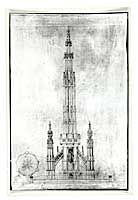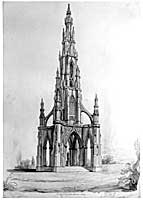 The
competition to design a monument to Sir Walter Scott was launched
in Spring 1836 with the proviso that 'no architectural monument
should be adopted of which a statue did not form a part', and that
it should be Gothic in style. The project was to cost £5000. The
competition to design a monument to Sir Walter Scott was launched
in Spring 1836 with the proviso that 'no architectural monument
should be adopted of which a statue did not form a part', and that
it should be Gothic in style. The project was to cost £5000.
The competition was opened to all and fifty-four entries were received
including 22 Gothic structures, 11 statues in an architectural setting,
14 Grecian temples, five pillars, one obelisk and a fountain.
Prizes of fifty guineas were offered for the top three designs.
Two were from well known architects, the third (pictured to the
left, a simplified structure of the Monument we know so well today)
under the pseudonym of John Morvo - the stonemason concerned with
work at Melrose Abbey in the 15th century. This was in fact from
George Meikle Kemp, a working joiner who was an accomplished draughtsman.
There was much discussion about the merits of the designs, but
although all agreed Kemp's design was 'an imposing structure…in
beautiful proportions', there was prejudice against his non-architectural
background.
Further designs were sought, and many new entries were submitted
including designs from Sir William Allan and William Playfair, the
architect. However Kemp's revised design won the day.
 To the right is Kemp's winning competition drawing for the Scott
Monument, presented to the City Council by Charles H. Taylor in
1938.
To the right is Kemp's winning competition drawing for the Scott
Monument, presented to the City Council by Charles H. Taylor in
1938.
William Burn, architect said of the design:
'Its purity as a Gothic monument, and more particularly
the constructive skill exhibited throughout, in the combination
of graceful features of that style of architecture… the composition
and in the perfect solidity which it would possess when built'.
At the same time the result was announced that Sir
John Steell was unanimously selected to undertake the sculpture
of Scott at the base of the monument. His statue of Sir Walter Scott
is executed in Carrara marble and is more than double life-size.
 George
Meikle Kemp was born in Moorfoot, Midlothian on 25th May 1795. He
was a working joiner who became a self taught draughtsman. Later
he worked for William Burn, the architect, making drawings of Bowhill,
the Duke of Buccleuch’s mansion in Ettrick. He attracted attention
by his accurate and detailed drawings of Melrose Abbey which were
exhibited at the Scottish Academy in 1830. George
Meikle Kemp was born in Moorfoot, Midlothian on 25th May 1795. He
was a working joiner who became a self taught draughtsman. Later
he worked for William Burn, the architect, making drawings of Bowhill,
the Duke of Buccleuch’s mansion in Ettrick. He attracted attention
by his accurate and detailed drawings of Melrose Abbey which were
exhibited at the Scottish Academy in 1830.
Fundraising for the monument started with donations of £500
from five of the Scottish banks and one of the earliest responses
to the appeal was 1525 roubles (over £68 in 1833) from bankers
in St Petersburg. Further funds came from groups organised in Glasgow,
Perth and Selkirk, and even King William IV gave £300.
Later when lack of funds hit, house-to-house visits in Edinburgh
were arranged to collect money, and an engraving of the monument
was given to everyone who contributed one guinea or more. |



